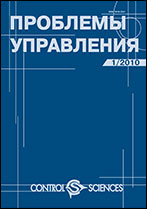|
Information technologies controls
The simultaneous start of actions in a distributed group of automatic devices: a decentralized control method with a signal repeater
G.G. Stetsyura
Trapeznikov Institute of Control Sciences, Russian Academy of Sciences, Moscow, Russia
Abstract:
This paper proposes a method for accelerating decentralized synchronization processes in the distributed control of a group of stationary or mobile automatic objects. With this method, the objects pass to specified states or affect the environment simultaneously or with required time delays. Some examples of such objects include actuators, computers in a computing cluster, distributed data processing facilities in supercomputers, and mobile robots. The object's action depends on the current state of all objects and the environment. The actions should start with minimum delay after detecting the possibility to perform them. Arbitrarily located sources of executive commands and their receivers are synchronized by exchanging signals and messages between objects through an intermediary (a signal repeater). Means are used to accurately measure the time intervals of signal transfer between each object and the repeater. Group operations are used to accelerate synchronization processes. These operations involve a large number of objects simultaneously. The object's data are used in operations simultaneously. Data are processed during their transmission without extra time. Operations are executed by network devices of the system objects and the common network device without any computing facilities (the repeater).
Keywords:
simultaneous start of group operations, decentralized control, synchronization of mobile objects, fast distributed intranet computing, multilayer synchronization.
Received: 28.11.2021
Revised: 05.05.2022
Accepted: 19.05.2022
Citation:
G.G. Stetsyura, “The simultaneous start of actions in a distributed group of automatic devices: a decentralized control method with a signal repeater”, Probl. Upr., 2022, no. 3, 55–64; Control Sciences, 2022, no. 3, 46–54
Linking options:
https://www.mathnet.ru/eng/pu1282 https://www.mathnet.ru/eng/pu/v3/p55
|

| Statistics & downloads: |
| Abstract page: | 66 | | Russian version PDF: | 27 | | English version PDF: | 27 | | References: | 14 |
|




 Contact us:
Contact us: Terms of Use
Terms of Use
 Registration to the website
Registration to the website Logotypes
Logotypes







 Citation in format
Citation in format 